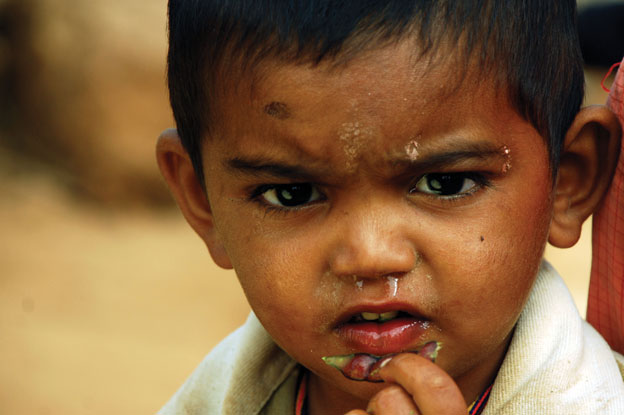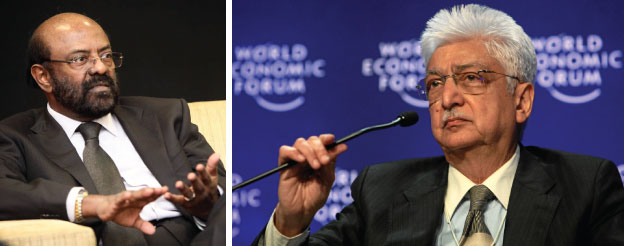COVER STORY:
Indian Philanthropists: Striving to End Inequalities
India’s association with philanthropy may be ancient but not too many high net-worth Indians
can flaunt donations that commensurate the wealth they flaunt. Going by the latest figures that reveal India’s billionaire contingent of 103 forming the sixth largest group in the world, one can only expect the scope of this tradition of giving to enlarge in imaginative ways and eventually set new trends. Marking a beginning is IT giant, Wipro’s head, Azim Premji, who also is one of the country’s foremost billionaires, writes Priyanka Bhardwaj.

In the second edition of Hurun Indian Philanthropy List (2013), compiled by China-based Hurun Report Inc., Azim Premji was ranked amongst very high profile donors for having made donations of up to Rs. 80 billion last year toward philanthropic causes.
Recently, he was in news for transferring 12.5 percent of his stake in Wipro — worth $ 2.2 billion — out of a total of 57 percent, to the Azim Premji Trust.
He also enjoys the honor of being the first Indian and third non-American to have joined the Giving Pledge campaign started by Bill Gates and Warren Buffet in 2010 that encourages wealthy persons and families across the globe to donate sizeable portions of their wealth to charities.
Coming back to the Hurun report, it compared corporate donations made by various promoters and entrepreneurs from India and found that philanthropists from the country made maximum contributions to Reuters Education (Rs. 122 billion), followed by social development (Rs. 12.1 billion), healthcare (Rs. 10.65 billion), rural development (Rs. 5.65 billion), environmental cause (Rs. 1.7 billion) and agriculture (Rs. 0.4 billion).
This list names Shiv Nadar of HCL group, with his contribution measuring up to Rs. 30 billion, for the cause of Shiv Nadar Foundation, a two decade-old endeavor focused on education, as the second most significant Indian donor.
Some other Indian donors who find mention in the list include G.M. Rao whose GMR Varalakshmi Foundation spent Rs. 7.4 billion for education of underprivileged children, Nandan and Rohini Nilekani with his donations of Rs. 5.3 billion, Ronnie Screwvala of UTV group who contributed Rs. 4.7 billion for rural empowerment, Kiran Mazumdar Shaw of Biotech with her donation of Rs. 3.3 billion, Ratan Tata who forwarded Rs. 3.1 billion toward several charitable organizations for the underprivileged through JRD Tata Trust and Sir Ratan Tata Trust, Vedanta Resources Chairman Anil Agarwal, P.N.C. Menon of Sobha Developers and DLF Chairman Kushal Pal Singh.

(Above, left): Shiv Nadar. (Above, right): Azim Premji. [Photo: Monikia Flueckiger | World Economic Forum | swiss-image.ch]
The recent spurt in the philanthropic sector may serve to improve India’s image considering its lowly rank of 133 in the World Giving Index, below Bangladesh at 109 and Nepal at 115, and a recent Bain report on Indian philanthropy that talked of private charity contributions amounting to a mere 0.04 percent of the total GDP of India compared to 1.3 percent and 2.2 percent of the U.K. and U.S. respectively.
In order to harness corporate competency toward creation of an enabling and catalytic environment of philanthropy that achieves decisive goals, the Government of India recently came up with the Corporate Social Responsibility (CSR) in the Companies Bill that mandates firms to contribute 2 percent of their earnings for charitable causes.
The Companies Bill 2013 rules that firms worth more than Rs. 5 billion, or accruing revenue of more than Rs. 10 billion, or net profit of more than Rs. 0.05 billion would need to allot two percent of their average net profits of the preceding three years for CSR activities.
Praising the government intervention, Dileep Rangekar, co-CEO of Azim Premji Foundation, emphasized, “When organizations and individuals don’t do something willingly, the state steps in. In the long run, a practice of setting aside a percentage of your profits to societal good would be useful as long as it does not come across as coercion.”
Samar Jodha, an artist who uses photography and filmmaking to address social issues like development, human rights and conservation says, “Indian philanthropy has moved from its traditional form which was very connected to cultural/religion/karma belief whence a rich Marwari would run home for widows or trading communities would run schools, hospitals or even a water tap during hot Indian summer to an altogether different story. In contemporary times, corporates have realized the impact of larger public opinion by spending small part of their profits into issues. Also the social media has played a role in making people put their hands in their pockets.”
Having said that, he adds a dash of critique, “And who doesn’t want to wear a good T-shirt while writing-off on taxes in today’s world of crony capitalism.”

There are many who oppose this “2 percent rule” or “forced philanthropy” as they prefer to call it among the so called corporates as well, like Ajay Kela, CEO and president of Wadhwani Foundation who states, “Provisions should be put into place to ensure that focus remains on the company’s overall real responsibilities inside its fence. Companies get away with a lot of things, like pollution of water sources. There is no use doing charity outside if you cause some of the problems yourself. I would say that the media and public pressure has to remain on inside-the-fence corporate practice.”
While one may debate the appropriate models for this sector, it is essential to recognize indigenous culture of giving that have been ancient and more quiet, largely direct and hence of less impact, ad-hoc, short term and mostly linked to religion.
This culture was largely undocumented and pertained to donations of gold, silver, livestock, grains, flowers, and income from land – grants made by royal patrons or wealthy individuals to temples and religious institutions for undertaking educational, socio-cultural and other charitable activities for the society.
Though Hindu scriptures recommended devotees to follow dharma (religious duty) and indulge in sewa (service of needy) and lok sanagraha (universal human welfare), donations or dana (giving) were never considered obligatory.
The importance of dana as laid down by Isha Upanishada, a Hindu philosophical text, is that it is regarded as a path to earn punya (merit for salvation), prayaschit (repentance), aparigriha (non-accumulation of wealth) and karuna (compassion).
In line with this, many kings or maharajas gave substantial sums for construction of dharamshalas (rest-houses), roads, digging of wells, planting of trees, etc.

This practice has survived till date and several religious sects like Sathya Sai Sewa organization, Adhiparasakti Peetham, Chinmaya and Ramakrishna Mission that have established educational and healthcare institutions and provided relief at times of disaster, and progressed into initiatives for rural development, water conservation etc.
Another brilliant example is the famous Vishnu temple that houses the Tirupati deity in Andhra Pradesh that receives more than 50,000 pilgrims on a normal day and collects donations amounting to approximately $165 million annually.
Even Muslims and rulers of this denomination were bound by the Quran and Hadeeth to contribute towards zakat (obligatory charity) that was meant to bring in social security to the ‘have nots’ and sadaqah (voluntary almsgiving).
Experts feel that global practices can be fused with these local cultures of charities to make way for powerful models of philanthropy.
Nandan Nilekani, co-founder of Infosys and a philanthropist, explains that, “All over the world, people will always keep doing charity, something which is based on empathy. You see someone in need and you reach out. And that is something to celebrate. Now as societies become more globalized and modern, a new kind of wealth creation will evoke a new response, partly inspired by Western models. The newly wealthy are going to engage with new social issues and they are going to look more systematically at their resolution.”
Going by the latest figures that reveal India’s billionaire contingent of 103 forming the sixth largest group in the world, one can only expect the scope of this tradition of giving to enlarge in imaginative ways and eventually set new trends.
As Suhel Seth, managing partner of Counselage India, a marketing maven and frequent speaker rightly said, “In an unequal world, humanity must strive for equality and for that there can be no substitute to compassion and philanthropy.”
|